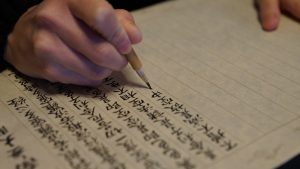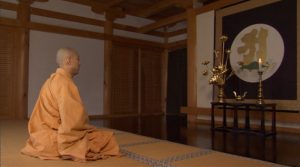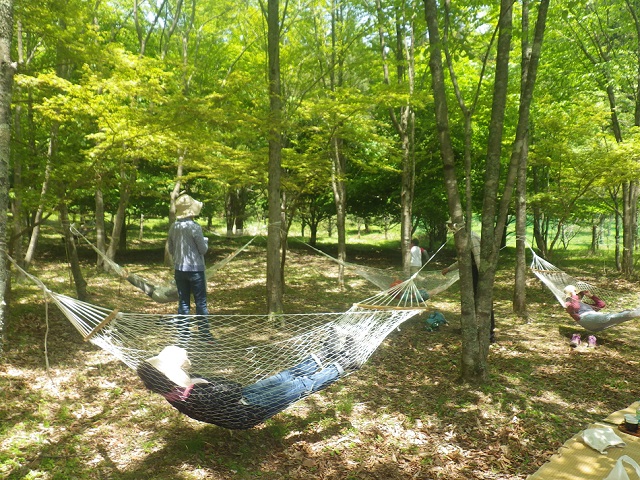Experience Buddhism
For visitors looking to take part in an authentic Buddhist experience, there are many activities one can enjoy in Koyasan, include things such as religious ceremonies, mediation, and sutra copying.
Buddhist Sutra Copying

The practice of copying Buddhist scriptures or sutras as they are commonly referred to has long been popular throughout East Asia. The practice of copying sutras is not a difficult one and is used both as a form of meditation and as an act of religious devotion. As sutras are the authoritative source of Buddhist teachings, and because of the merit their teachings contain, it is thought that copying a sutra has great spiritual value. In Japan, the faithful will often dedicate copying a sutra for the repose of a deceased loved one, or for some prayer or wish they hope to have fulfilled. It is also believed that carefully and slowly copying each of the Chinese characters of a sutra will provide a relaxed and refreshed mental state of mind.
The Heart Sutra is one of the most popular sutras to copy, and its popularity is due to the short length (only 262 characters) of this text. Though a relatively short text, this sutra captures the essential teachings of Mahayana Buddhism, which is yet another reason for its popularity. A simple translation is provided below, and it is hoped that through copying the Heart Sutra, one can appreciate its profound meaning and investigate it further.
Hannya Shingyo, the Heart Sutra, is praised as follows: “It teaches us about the wisdom of Shingon – the grand core of the wisest bodhisattva. The entire sutra fits on a single page, reaching a mere 14 lines. Despite its simplicity, it gets the main point and has deep meaning.”
Kobo Daishi Kukai wrote in his Secret Key to the Heart Sutra:
Reciting, upholding, explaining, and revering the Heart Sutra will relieve suffering and provide ease. Practice what it teaches and meditate on it, and you will attain enlightenment and the wisdom of the Buddha.
Through copying the Heart Sutra and coming into contact with its profound teachings, may you and all beings experience release from suffering and enjoy peace.
Ajikan Meditation

Ajikan is a form of meditation that was originally used by monks to relax and train their minds, and in recent years visitors coming to Koyasan have been taking an interest in this practice. Because of this growing interest, tourists can now also take part in this unique form of meditation while visiting Koyasan.
When practicing Ajikan (as depicted above), one focuses on the Sanskrit letter “A” and the image of a lotus below the letter. These images are meant to represent the physical heart and knowledge.
Jukai Ceremony
Jukai is an ancient Buddhist ceremony for taking refuge in the Buddha and receiving Buddhist lay precepts. Anyone, regardless of their religious beliefs or background may receive these precepts, which are thought of as guidelines for living a wholesome and virtuous life. You do not need to be a Buddhist to receive these precepts, and receiving them does not necessarily make you a Buddhist unless you wish it to be so. Traditionally, a person with the aspirations to follow the Buddhist path becomes a Buddhist layperson by taking refuge in Buddhism and receiving the precepts in a ceremony such as this.
It has been taught since ancient times that formally receiving the Buddhist precepts from a master produces great merit, and receiving such precepts are the fundamental core practice of a Buddhism. Kobo Daishi (Kukai) the founder of Shingon Buddhism in Japan, wrote this of the precepts:
所謂十善者身三語四意三也。摂末帰本一心為本。一心之性与仏無異。我心衆生心仏心三無差別。住此心即是修仏道。
Among the Ten Wholesome Precepts, three concern the body, four concern speech, and three mind. These ten are the branches, and the one-mind is the root. The essence of the one-mind is no different from the Buddha. My mind, the minds of all sentient beings, and the mind of the Buddha are three, but there is no difference among them. Abiding in this mind is called cultivating the path of the buddhas.
Today, one can receive the same precepts that have been given to the Buddhist laypeople since ancient times at the Daishi Kyokai Training Center by a fully ordained Buddhist master. This ceremony is the same ceremony that was practiced for over 2,500 years originating with the physical Buddha Shakyamuni.
Night Tour
Currently, there are 3 groups that operate night tours in Koyasan.
For details, please refer to the details below.
Entire Koyasan Area
・KCCN (Guided Tour)
Okuno-in
・Night Tour (Japanese and English)
Danjo Garan Area
・Garan Twilight Wanders
Forest Bathing (only in Japanese)
This is an activity for restoring the natural energy of the body and mind through the conscious use of all five senses. One is to take in this restorative energy of the forest’s natural landscape through the views, smells, sounds, and sensations that the landscape has to offer.

In 2007, Koyasan was certified as a Forest Therapy Center, and one can take part in this therapeutic experience while relaxing in the forests of Koyasan.
Please understand that this activity is conducted in Japanese only, so participation is limited to people who understand Japanese or who have a translator with them.
Koyasan Temple Forest Association
Address: 45-17 Koyasan Koya-cho, Ito-gun, Wakayama Prefecture
Phone: 0736-56-2828 External Link
